
Detailed business case template
<Insert project title>
<Insert sponsoring agency>
<Insert date>
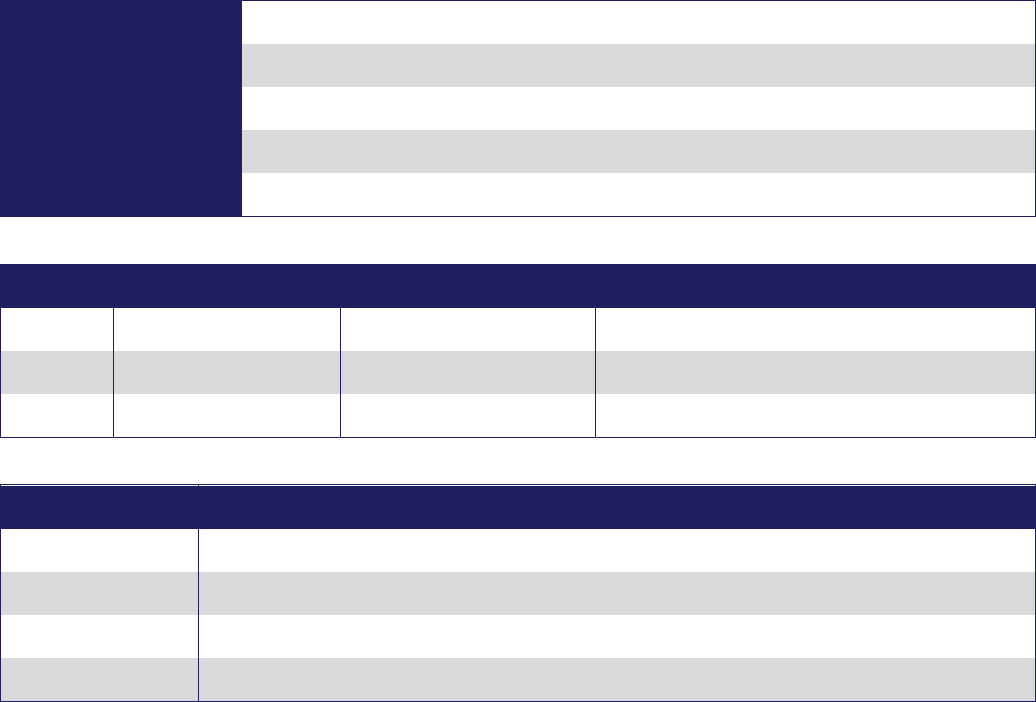
Document title Detailed business case template
Contact details Development Strategy, 08 8999 6035, EconomicInnovation.DTBI@nt.gov.au
Approved by
Date approved
Document review Annually
Version
Date
Author
Changes made
1.0 17 July 2019 First version
Acronyms
Full form
NT Northern Territory
NT Government Northern Territory Government
NTPDF Northern Territory Project Development Framework
Please read in outline view for best navigational experience.

Detailed business case template
What is a Detailed Business
Case?
The Detailed Business Case is a single complete
document used by senior decision makers to assess a
proposed project.
If approved, it confirms support and/or resourcing for
a recommended course of action (option).
A Detailed Business Case is developed to:
• gain agreement on the project scope and
approval to proceed with a project
• obtain resourcing for a project through
internal departmental processes, and
• to document what the project will accomplish
for the funding and how it will deliver
benefits.
Why use this document?
The guidance in this document aims to clarify the
NT Government’s expectations for Detailed Business
Cases as part of the Northern Territory Project
Development Framework (NTPDF).
Providing a framework for project development assists
in:
• the consistent assessment of Business Cases
to achieve the best value for Territorians
• reducing the costs and time taken to develop
Business Cases, and
• ensuring Business Cases meet NT and Federal
Government requirements.
When would you develop a
Strategic Business Case?
Approval to develop a Detailed Business Case is
usually obtained from the Project Sponsor, after an
initial Strategic Business Case has been completed and
approved.
The Detailed Business Case expands the proposal
developed to date in order to:
• obtain approval for resourcing for the
preferred option
• attain agreement on the scope of the project,
and
• gain authorisation to proceed to the next step
of the project.
The Detailed Business Case will be an important
document for developing the Project Plan as well as
other project documentation, and measuring the
success of the project.
What you need before you start:
• Agreement to proceed with the development
of the Business Case from the Project
Sponsor.
• Agreement establishing the scope of the
Detailed Business Case.
• Knowledge and understanding of the
development of a Business Case, as outlined
in the NTPDF.
Further help and additional
guidance
The NTPDF outlines details on project development in
the NT Government. The NTPDF is a tool to guide
project development to ensure government facilitated
and funded projects are well defined and that
government resources are invested in the right
projects.
Support can be provided at any stage of a project’s
lifecycle by the Department of Trade, Business and
Innovation by telephone on (08) 8999 6035 or via
email at economicinnovation.dtbi@nt.gov.au
The NT Government also encourages users of the
NTPDF to leverage the specialist skill sets available
across agencies to help validate, check and/or
collaborate on a project.
Detailed business case template
Contents
What is a Detailed Business Case? ................................................................................................................................. 3
Why use this document? ............................................................................................................................................... 3
When would you develop a Strategic Business Case? ............................................................................................ 3
What you need before you start:................................................................................................................................. 3
Further help and additional guidance ......................................................................................................................... 3
1. Executive Summary ....................................................................................................................................................... 6
1.1. Introduction .............................................................................................................................................................. 6
1.2. Outcomes ................................................................................................................................................................. 6
1.3. Scope ......................................................................................................................................................................... 6
1.4. Stakeholder Engagement ....................................................................................................................................... 6
1.5. Cost Estimate ........................................................................................................................................................... 6
1.6. Budget Impact Summary ....................................................................................................................................... 6
Project Development Funding ................................................................................................................................ 6
Indicative Project Costs ............................................................................................................................................ 7
Staffing Impacts Summary ....................................................................................................................................... 7
1.7. Summary Cost for each project phase (if applicable) ....................................................................................... 7
1.8. High-level Timeline/Duration ............................................................................................................................... 8
2. Project Outline ................................................................................................................................................................ 8
2.1. Background............................................................................................................................................................... 8
2.2. What Initiated the Project ..................................................................................................................................... 8
2.3. Why Do We Want To Do It .................................................................................................................................. 8
2.3.1. Strategic Intent and Alignment .................................................................................................................... 8
2.3.2. Key Project Drivers ........................................................................................................................................ 8
2.4. Project Options Analysis ........................................................................................................................................ 9
2.4.1. Options Assessment ...................................................................................................................................... 9
2.4.2. Stakeholder Impacts ....................................................................................................................................... 9
2.5. Outcome of Options Assessment ........................................................................................................................ 9
2.5.1. The Reference Project ................................................................................................................................... 9
2.5.2. Performance Measurement and Baselining .............................................................................................. 9
Target measures ................................................................................................................................................... 10
3. Financial and Commercial Assessment ................................................................................................................... 10
3.1. Detailed Cost Estimates and Risks.................................................................................................................... 10
3.2. Project Funding Analysis .................................................................................................................................... 12
4. Public Benefit Assessment ........................................................................................................................................ 13
4.1. Benefits .................................................................................................................................................................. 13
4.2. Costs ....................................................................................................................................................................... 13
4.3. Qualitative Analysis ............................................................................................................................................. 14
4.4. Quantitative Analysis .......................................................................................................................................... 14
Detailed business case template
4.4.1. Cost Benefit Analysis ................................................................................................................................... 14
5. Delivery and Funding Model Analysis .................................................................................................................... 14
5.1. Outline of Key Risks ............................................................................................................................................ 15
5.2. Procurement Value Drivers ................................................................................................................................ 15
5.3. Delivery Model Assessment............................................................................................................................... 15
5.4. Funding Model ...................................................................................................................................................... 17
5.5. Recommended Delivery/Funding Model ........................................................................................................ 17
5.6. High-level Delivery Schedule ............................................................................................................................. 17
6. Project Governance and Assurance ........................................................................................................................ 17
6.1. Governance Arrangements ................................................................................................................................ 17
6.2. Communications Management ......................................................................................................................... 19
6.3. Risk Management ................................................................................................................................................. 20
Types of Risk ............................................................................................................................................................. 20
Likelihood Categories .............................................................................................................................................. 20
Impact Categories .................................................................................................................................................... 21
Matrix for Rating Risks ............................................................................................................................................ 21
Risk Exposure Categories ....................................................................................................................................... 22
Risk Management Strategies: Dominant Strategy ............................................................................................ 22
6.3.1. Risk Management Plan ................................................................................................................................ 23
7. Endorsement & Gate Review .................................................................................................................................... 24
Gate Review .................................................................................................................................................................. 24
8. Next Steps ..................................................................................................................................................................... 24
Post Implementation Review ..................................................................................................................................... 24
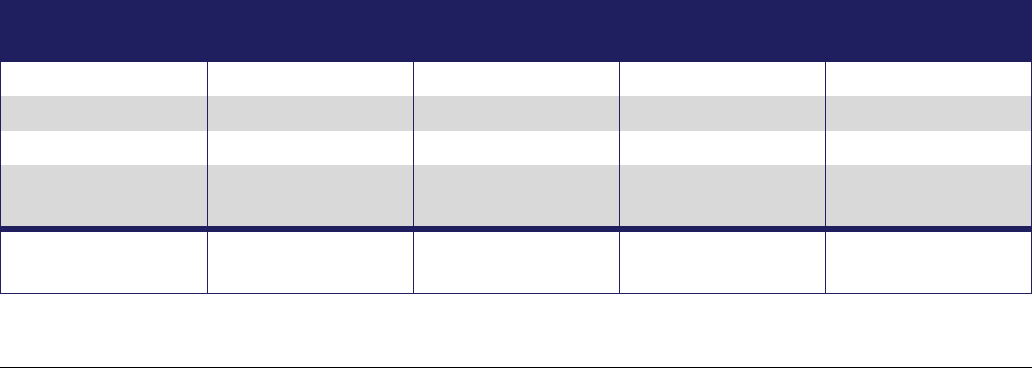
Detailed business case template
Department of
TRADE, BUSINESS AND INNOVATION
17 July 2019
| Version 1
Page 6 of 24
1. Executive Summary
1.1. Introduction
This section should cover:
• What the strategic need that is being addressed is
• What the Public Benefit is
• The likely outcome if Government does not take action to address the strategic need
• What the Detailed Business Case is proposing
• The project size
• Potential and/or expected funding sources
1.2. Outcomes
Brief summary of Section 2.4.1 Project Outcomes.
1.3. Scope
Brief summary of Section 2.4.2 Project Scope.
1.4. Stakeholder Engagement
Brief summary of Section 2.5 Stakeholder Engagement.
1.5. Cost Estimate
Summary of Section 3.1 Detailed Cost Estimate.
1.6. Budget Impact Summary
Project Development Funding
This section takes into account the cost of investigating options and scoping the project.
Budget Impact
Current Year
$000
Future Years
$000
Recurrent
Capital
Offset savings
Revenue
Implications
Net Funding
Requirements

Detailed business case template
Department of
TRADE, BUSINESS AND INNOVATION
17 July 2019
| Version 1
Page 7 of 24
Indicative Project Costs
Detail the high-level indicative project costs (construction and whole-of-life costs).
Budget Impact
Current Year
$000
Future Years
$000
Recurrent
Capital
Offset savings
Revenue
Implications
Net Funding
Requirements
Staffing Impacts Summary
Impact
2018-19
2019-20
2020-21
2021-22
Total Additional FTEs
1.7. Summary Cost for each project phase (if applicable)
Allocated Cost per Phase Outcomes to Phase
Phase 1 $x,xxx,xxx
<Sunk costs incurred on project set up>
<Business Case development and submission>
Phase 2 $x,xxx,xxx
<Milestone>
<Milestone>
Phase 3 $x,xxx,xxx
<Milestone>
<Milestone>
Phase 4 $x,xxx,xxx
<Milestone>
<Milestone>
Contingency $x,xxx,xxx
<Milestone>
<Milestone>
Total Requested $x,xxx,xxx
<Milestone>
<Milestone>
Estimated Total Cost
to Completion
$x,xxx,xxx Comments
The Estimated Cost to Completion (ECTC) represents the total funding envelope required from the
inception of the project through to the completion of the project.

Detailed business case template
Department of
TRADE, BUSINESS AND INNOVATION
17 July 2019
| Version 1
Page 8 of 24
1.8. High-level Timeline/Duration
Provide a high-level breakdown of the proposed key project dates currently known to the project.
<Include attachment of any schedules developed>
2. Project Outline
This section covers the details of the proposed project with a focus on the problem to be addressed or
opportunity to be harnessed.
2.1. Background
Expand details on the proposed project. Why has it been proposed and who has been involved in the
process?
2.2. What Initiated the Project
• What is the strategic issue or opportunity that is being addressed?
• What are high level project timeframes?
• What may occur if the investment is not undertaken and the impact?
2.3. Why Do We Want To Do It
Clearly articulate the problem or opportunity and the benefits which will be realised if the project is
progressed
2.3.1. Strategic Intent and Alignment
Describe the strategic intent of the project and what areas of policy and/or area of government or private
sector that are the driving force behind the project.
2.3.2. Key Project Drivers
This section should provide an overview of what the project aims to deliver and the impacts of the project
on NT Government, economy, business and wider community (as applicable).
Building on work already completed as part of the Strategic Business Case, clearly outline, among other
things:
1. why the project is considered important and implications of the project not proceeding;
2. what economy and/or jobs enhancing outcomes will be achieved by the project proceeding; and
3. all project constraints and how these are proposed to be addressed.
A completed Benefits Realisation Report should be attached to the final Detailed Business Case.

Detailed business case template
Department of
TRADE, BUSINESS AND INNOVATION
17 July 2019
| Version 1
Page 9 of 24
2.4. Project Options Analysis
This section is the critical section in the Detailed Business Case and is a detailed assessment of the risks,
benefits, opportunities and threats presented by each option. The assessment of options is expected to
result in articulation of the preferred option (the Reference Project) with the analysis clearly supporting
such identification.
2.4.1. Options Assessment
The section reviews the options analysis undertaken as part of the Strategic Business Case and:
1. summarises the shortlisting and filtering process undertaken to identify the options to deliver the
project outcome;
2. provides a detailed reassessment of the shortlisted options identified in the Strategic Business
Case;
3. assesses in detail options identified following the Strategic Business Case; and
4. explains the rationale for discarding any options identified in the Strategic Business Case.
2.4.2. Stakeholder Impacts
In relation to each of the options, describe the government and external (business/community)
stakeholders that are impacted by the proposed project, the nature and level of impact and, where there
are negative impacts, how these impacts will be managed and mitigated.
Stakeholder Effected
Impact <major,
moderate or minor>
How affected Proposed Mitigation
2.5. Outcome of Options Assessment
2.5.1. The Reference Project
Provide clear details of the scope of the Reference Project, what the Reference Project will accomplish,
clearly articulate what outcomes will be achieved, and what makes it the preferred approach to resolving
the issue or leveraging the opportunity.
2.5.2. Performance Measurement and Baselining
This section articulates the approach to be taken and framework to be established to measure how well
the Reference Project achieves project outcomes.
Benefit measurement needs to be evidence based. The approach for collecting data and measuring
performance needs to be able to be validated and agreed with all key stakeholders.
As part of project delivery, the performance baseline has to be established with data collected to enable
performance measurement over time.

Detailed business case template
Department of
TRADE, BUSINESS AND INNOVATION
17 July 2019
| Version 1
Page 10 of 24
Target measures
A target represents a desired level of performance for a specific outcome. For example, if travel speed is
the specific outcome, the target might be 40 kms/hr. Measurable and realistic targets, albeit ones that are
still challenging, need to be set during project planning.
In setting target measures, timeframes for the achievement of targets should consider the scale of
initiatives and realistic timeframes.
Example Table
Outcome KPI KPI Owner Benefit metric
Baseline
Measure
Target
Measure
The name of the
relevant
outcome
How the
outcome will be
evaluated
Stakeholder
responsible for
measurement
and reporting
Financial/non-
Financial
The starting
figure at
commencement
of the project
Your expected
figure after the
project
Increased
visitor nights
Darwin
overnight visits
increase
Tourism NT Non-financial xxx
Increase of 5%
by 2020
Improve road
safety
Reduced
fatalities
NT Police Non-financial
X number of
fatalities in
2017
10% reduction
in fatalities
from crashes
by 2020
Source: The Australian Transport Assessment and Planning Guidelines: T6 Benefits Management.
3. Financial and Commercial Assessment
The purpose of this section is to undertake a high-level financial assessment of shortlisted project options
to enable the financial and commercial implications of each shortlisted option to be clearly understood. A
more detailed financial assessment is to be undertaken of the Reference Project.
Completion of the financial analysis provides a set of baseline cash flows. This can be used in the
development of cost comparators which are used to assess value for money.
The business case should seek to place a quantifiable value on the extent of financial risks to the project
benefits as much as possible.
Detailed capital and operational cost estimates should be included as appendices to the business case.
3.1. Detailed Cost Estimates and Risks
At this stage of project development, the cost estimates of the shortlisted options should be provided at
P50 level with cost estimates for the Reference Project provided at both the P50 and P90 levels of
confidence, capturing capital costs, whole-of-life operating and maintenance costs, and any savings that
would be realised by deviating from the base case. P50 costs and P90 costs are estimates of project costs
based on 50% and 90% probability respectively that the cost estimate will not be exceeded. The P50 cost
is the median of the cost distribution. See Graph 1 for an illustration of P50 and P90 costings.
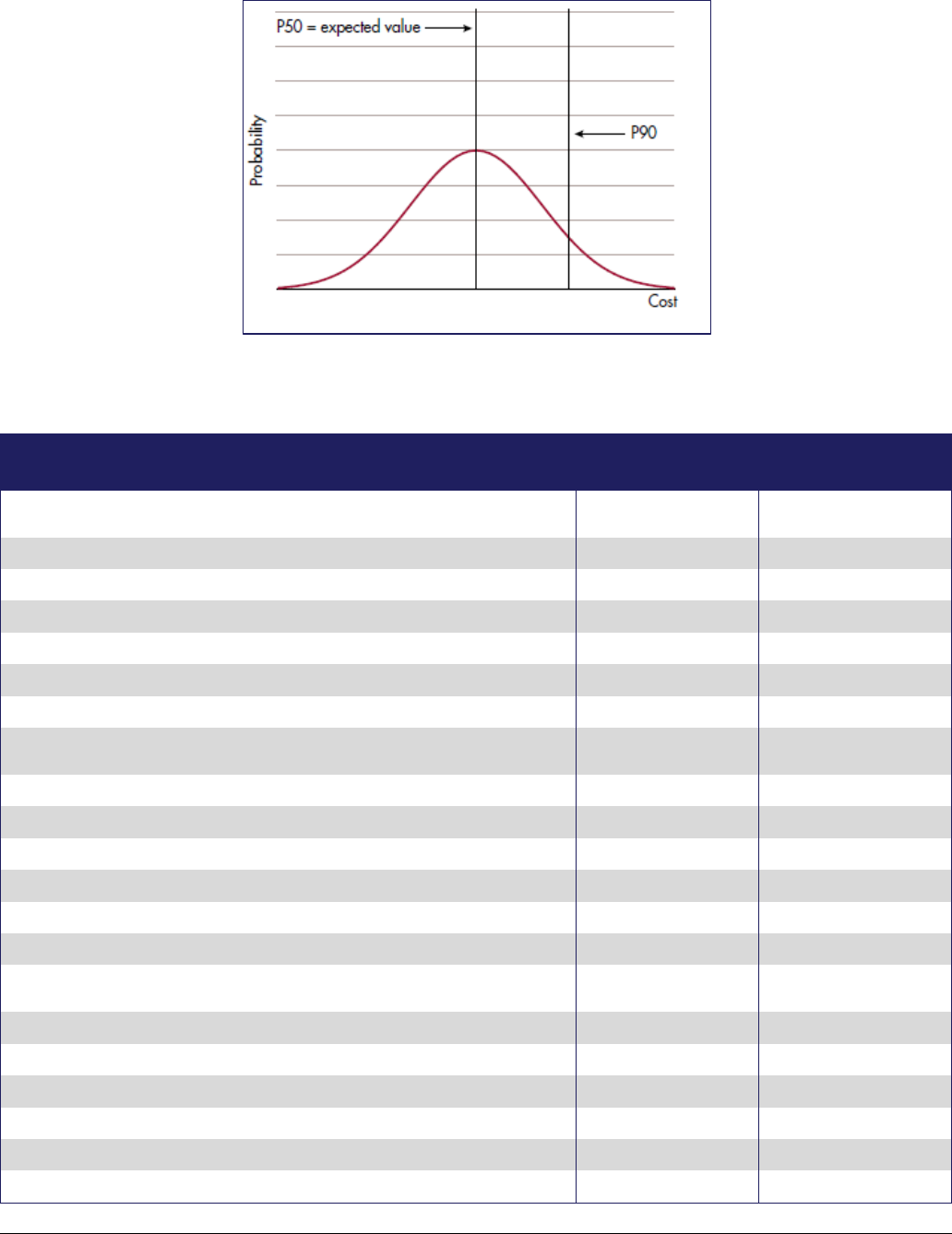
Detailed business case template
Department of
TRADE, BUSINESS AND INNOVATION
17 July 2019
| Version 1
Page 11 of 24
Graph 1: Symmetrical Cost Distribution.
Source: Infrastructure Australia’s Assessment Framework, June 2017, p.41
Table 1: Example of Capital Cost Estimates
Capital Cost Estimates
P50 Cost
$m
P90 Cost
$m
OPTION 1 – REFERENCE PROJECT
Design, project management, other fees 5 7
Land 6 10
Demolition 1 1
Building works 30 45
Contigencies
38
20
Total
80
90
OPTION 2
Design, project management, other fees
5
Land 6
Demolition 1
Building works 40
Contigencies 46
Total
98
OPTION 3 – BASE CASE
Design, project management, other fees 5
Land
Demolition
Building works 60
Contigencies 46
Total 111

Detailed business case template
Department of
TRADE, BUSINESS AND INNOVATION
17 July 2019
| Version 1
Page 12 of 24
Budget Impact
Current Year
$000
Year 0 Year 1
Future Years
$000
Year 2 Year 3
CAPITAL COSTS
Design, project
management, other fees
2 2 1
Land 6
Demolition 1
Building works
15
15
OPERATIONAL COSTS
Staffing costs 2 5
Operating costs 1 2 4
Design, develop and
implement IT system
2 2
Repair and Maintenance
OFFSET SAVINGS
Redirected staffing
resources
1 3
REVENUE
User charges
NET FUNDING
REQUIREMENT
9 20 21 6
3.2. Project Funding Analysis
Outline the proposed funding sources for the project. This should include consideration of the ability to:
• charge users
• leverage Commonwealth or local government funding sources, and/or
• co-fund the project with non-government organisations.

Detailed business case template
Department of
TRADE, BUSINESS AND INNOVATION
17 July 2019
| Version 1
Page 13 of 24
Current Year
$000
Future Years
$000
Funding requirement
Capital
Operating
Total
Funding sources
NTG – Additional
NTG – Savings
Commonwealth
Other
Other
Other
Total
4. Public Benefit Assessment
The public benefit of the project needs to be clearly articulated and compared with the costs of proceeding
with the project. The depth of analysis and detail of reporting should be commensurate with project size
and/or the significance of the impacts/risks.
The broader impacts of projects are often key drivers for project selection in the NT. Matters such as social
equity in the availability of government services, accessibility to major employment hubs and connectivity
may not have measures that can be easily included in a quantitative Cost Benefit Analysis but are
important considerations in the development and assessment of projects and therefore should be included
in as much detail as possible in the Public Benefit Assessment.
4.1. Benefits
• What are the benefits of addressing the problem/harnessing the opportunity?
• This can include the costs avoided in developing the project, the direct benefits of the project
(e.g. reduced waiting times) and broader benefits (lower mortality rates from preventable illness)?
• The benefits need to be realistic, evidence-based and achievable.
4.2. Costs
• What are the costs of addressing the problem/harnessing the opportunity?
• Costs generally include the estimated capital and operating costs of delivering the project
(outlined in Section 3), regardless of who funds the project.
• This section should also discuss other broader costs that the project may generate as a result of the
project proceeding. These might include reduced amenity, carbon emissions etc.
The below provides further guidance on how to determine and present benefits and costs to provide a
view on the overall net public benefit of the project.

Detailed business case template
Department of
TRADE, BUSINESS AND INNOVATION
17 July 2019
| Version 1
Page 14 of 24
4.3. Qualitative Analysis
Outline the qualitative benefits, which may include environmental, social or regional considerations. These
can be a significant component of the project rationale, particularly in the NT context.
4.4. Quantitative Analysis
Quantitative analysis includes an assessment of the outcomes of the project in a manner that can be
reliably measured. e.g. the reduction in surgery waiting times as a result of a constructing a new operating
theatre, the increase in days a town has accessibility as a result of flood immunity works.
There are a range of quantitative tools that can be suitable to assist in assessing the public benefit of a
project, depending on the nature of the expected benefits and costs that the project is expected to
generate.
4.4.1. Cost Benefit Analysis
A Cost Benefit Analysis (CBA) is an assessment tool used to determine whether an option is beneficial
relative to the base case (‘do minimal or business-as-usual’).
The key principle of a cost-benefit analysis is to convert the costs and benefits into dollar terms, allowing
them to be weighed up against each other. An option will be considered more desirable if it delivers
benefits over and above its costs, which is typically expressed in net present value (“NPV”) terms.
The cost-benefit analysis differs from traditional financial analysis in that it is performed from the
viewpoint of society; specifically the NT community. For example, it could consider the road safety
benefits of a road improvement project. It goes beyond just looking at the fiscal impacts by also examining
social welfare impacts.
However, benefits and costs must be able to be converted into dollar terms for the analysis to be effective.
Continuing the example above, a road improvement project may also have a range of other benefits such
as improving accessibility to healthcare, education, job opportunities, trade and commerce etc. Such
indirect benefits are key drivers of projects in in regional and remote areas of the Northern Territory,
which are typically much more difficult to robustly estimate under a CBA.
Guidance material on cost benefit analysis can be found at the following links:
• the Department of Finance and Deregulation Finance Circular 2006/01, Australian Government
Introduction to Cost-Benefit Analysis and Alternative Evaluation Methodologies and Handbook of
Cost-Benefit Analysis
http://webarchive.nla.gov.au/gov/20080726194641/http://www.finance.gov.au/publications/fina
nce-circulars/2006/01.html
• The Green Book – Appraisal and Evaluation in Central Government, Treasury Guidance, London
2004 : http://www.hm-treasury.gov.uk/data_greenbook_index.htm
5. Delivery and Funding Model Analysis
This section identifies how the project will be delivered, funded and project delivery risks managed to
enable the Detailed Business Case to justify the delivery decision based on facts and analysis. The level of
detail involved in the analysis of options should reflect the size, scope and nature of the project.

Detailed business case template
Department of
TRADE, BUSINESS AND INNOVATION
17 July 2019
| Version 1
Page 15 of 24
Projects valued at $100 million or more must comply with the National Public Private Partnership (PPP)
Guidelines and consider a PPP approach for delivery.
In this section, key project risks and desired risk allocations are determined, and the relative importance of
various procurement criteria is established. Delivery options are identified, with an assessment of the
options against the evaluation criteria. Funding models are explored. A recommended delivery model will
be identified, and implications for procurement and a high-level delivery schedule provided.
5.1. Outline of Key Risks
Identify key project risks and desired risk allocations.
• Outline the process undertaken for risk management, i.e. was a Risk Workshop undertaken and
who participated?
• Attach a copy of the project’s Risk and Issues Register. The register should capture all relevant
project risks across all government agencies.
• Attach a Risk Management Plan which highlights the process to identify, assess, allocate and
monitor current, anticipated and emerging risks.
5.2. Procurement Value Drivers
Address the relative importance of each of the following criteria in the selection of the appropriate
delivery model:
• Time to Market: does the project need to meet a particular timeframe (government commitment,
closure of current facility etc.)?
• Flexibility: will the project benefit from a more flexible delivery model that accommodates
uncertainty and variation?
• Price certainty: Is fixed price certainty critical? To what extent would the project benefit from the
integration of outcomes beyond construction?
• Risk transfer: to what extent is the project suited to the transfer of risk to the contractual
counter-party?
• Contractor’s innovation and incentive: to what extent does the project provide opportunities to
drive innovation and incentivise the counter-party?
Develop a framework for the comparative analysis of the different procurement options, which
incorporates evaluation criteria and a system for rating each option against the criteria.
5.3. Delivery Model Assessment
Identify the different delivery options to be considered.
Design and construct is a common delivery model used by the NT Government, due to its clear scope and
comparatively low risk profile. This model is particularly common amongst smaller scale Level 2 and 3
projects. Projects that are larger-scale and more complex (i.e. have the potential for significant innovation
and may benefit from transferring operational risks to the private sector) may be better suited to another
model.

Detailed business case template
Department of
TRADE, BUSINESS AND INNOVATION
17 July 2019
| Version 1
Page 16 of 24
Delivery model options that can be assessed in this section include:
• Construct
• Design and Construct
• Design Construct Maintain
• Design Construct Maintain Operate
• Managing Contractor
• Alliance
• Public Private Partnerships PPP (Availability)
• PPP (Build Own Operate Transfer)
• Project Management Agreement
The following figure describes how value drivers can be aligned with the delivery model that achieves the
‘best fit’.
Delivery Model
Time to
Market
Flexibility Price Certainty
Innovation &
Incentive
Risk Transfer
Package drivers H/M/L H/M/L H/M/L H/M/L H/M/L
Construct Only Suitable Suitable Indifferent
Highly
unsuitable
Indifferent
Design & Construct Suitable Indifferent
Indifferent
Indifferent
Indifferent
Design Construct Maintain Indifferent
Unsuitable Suitable Suitable Suitable
Design Construct Maintain Operate Indifferent
Unsuitable Suitable Highly suitable Highly suitable
PPP (Availability)
Highly
unsuitable
Highly
unsuitable
Highly suitable Highly suitable Highly suitable
PPP (BOOT)
Highly
unsuitable
Highly
unsuitable
Highly suitable Highly suitable Highly suitable
Project Management Agreement Highly suitable Highly suitable
Highly
unsuitable
Highly
unsuitable
Highly
unsuitable
Managing Contractor Highly suitable Suitable Unsuitable Suitable Unsuitable
Alliance Unsuitable Highly suitable
Highly
unsuitable
Suitable
Highly
unsuitable
Source: ACT government SAF Guidelines
When evaluating the options, the following should be considered:
• Set timeframes associated with delivery options and assess their achievability
• Assess and rank each of the delivery options against the evaluation criteria
• Assess the potential value for money associated with each delivery option
A market analysis will be required for Level 1 projects, and at times Level 2 projects. Engage the market
through market soundings to:
• Identify key players
• Determine market capacity
• Determine market appetite, and
• Consider whether there is sufficient competition to drive value for money outcomes.

Detailed business case template
Department of
TRADE, BUSINESS AND INNOVATION
17 July 2019
| Version 1
Page 17 of 24
5.4. Funding Model
Summarise the range of potential funding and financing options that achieve best value for money for the
NT. Outline the likely funding risk for the proposed activity. Where alternative funding and financing
sources, such as Public-Private Partnerships (PPP), have been explored and are proposed, a more detailed
report of the options for funding should be incorporated into the business case and specialist advice
sought.
Key elements to consider include:
• Which potential options are most desirable? An outright private funding, joint government funding,
combined arrangement or alternative models including user pays or outcomes-based funding.
• What would be the likely extent of the financial exposure, co-investment and risk borne by the
NT Government under each arrangement?
• What would be the indicative net debt impact on the NT Government?
• What is the feasibility of adopting the funding model type?
5.5. Recommended Delivery/Funding Model
Summarise the recommended delivery model and the implications for procurement.
5.6. High-level Delivery Schedule
Provide a high-level delivery schedule that includes proposed procurement and delivery milestones.
Key Deliverable Change/Impact that will occur
<Business case> <Evidence to governance committees of merits of the project>
<Release EOI to market >
<Market/public are aware of intended project>
<Release of tender
documents to market>
<NT Government is committed to the project>
<Exchange of contracts> <This will enable parties to commence works>
6. Project Governance and Assurance
6.1. Governance Arrangements
This section outlines project governance arrangements that will be followed for the next phase of the
project. This will be confirmed as part of the Phase 2 approval process.
<Insert governance model used for the project describing the involvement of each party>
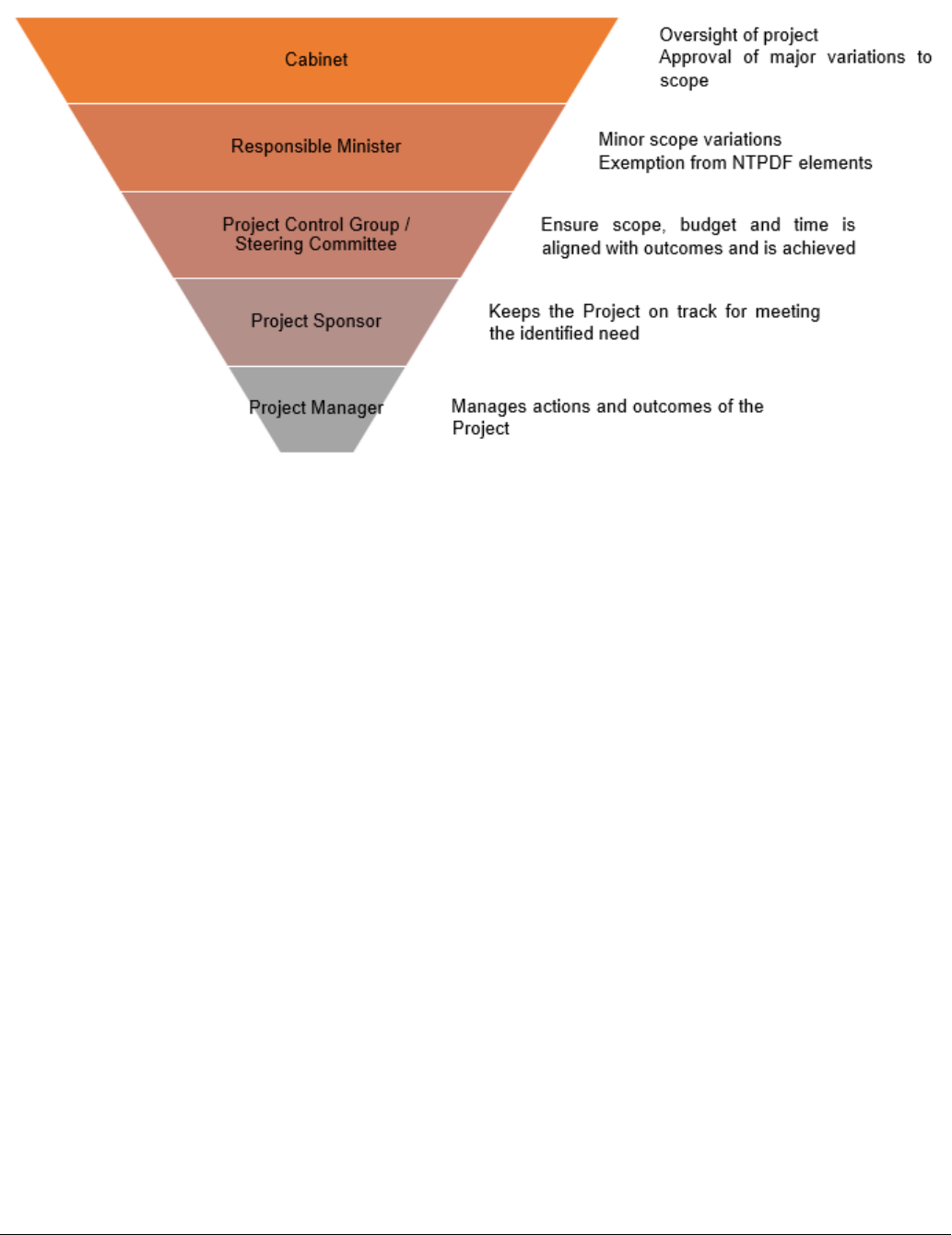
Detailed business case template
Department of
TRADE, BUSINESS AND INNOVATION
17 July 2019
| Version 1
Page 18 of 24
The typical governance structure is set out below:
Cabinet
Considers business case and makes investment decision
Responsible Ministers
Provides oversight of items raised for approval by the Cabinet.
Project Control Group / Steering Committee
The Project Control Group/Steering Committee includes a representative from relevant business areas or
agencies with the appropriate authority to take ownership of the operational decisions for their areas. The
Group/Committee will provide assurance and independence to the decision making process.
Project Team
The project shall employ the following project team roles (add/remove as needed).
• A Program Manager and/or Project Director
• A Project Manager for each area
• Procurement Officer
The above list is not exhaustive and provides an indication only of resource requirements. The allocation of
these roles could be sourced through a combination of internally and externally provided resources.
External Partnerships
If an external partnership is part of this project, describe what resources they shall be providing.
Outline the details of their participation in the project and how their actions will be governed.

Detailed business case template
Department of
TRADE, BUSINESS AND INNOVATION
17 July 2019
| Version 1
Page 19 of 24
An external professional services agency may be engaged to review and validate project progress on time,
budget and quality reviewing deliverables.
Project Documentation
Set out the milestones and project documents that will be examined to ensure that the project remains on-
track for success, as well as highlighting any potential shortcomings and/or corrective actions the project
may need to undertake.
6.2. Communications Management
The communications plan will identify the parties with an interest in the project and define the most
suitable means and frequency of project communications with them. The high-level approach the project
will adopt for reporting and review is shown in the table below. A full plan will be developed as part of the
Project Management Plan.
Communication Item Description Detail
Progress report – NTPDF
Highlight/Status Report
Rolled up status report showing
status, schedule progress versus
plan, budget actuals versus
forecast and significant risks or
issues for information of or
requiring governance decision or
assistance.
<Duration>
<Frequency>
<Audience>
<Owner>
Internal Communications
Communicate the planned work
and ensure all users are aware of
the requirements.
<Duration>
<Frequency>
<Audience>
<Owner>
Project team review meetings
Meetings to discuss current
status, review open issues, risks,
evaluate the impact of change
items to the project schedule, re-
negotiate commitments, and
review near-term project events.
<Duration>
<Frequency>
<Audience>
<Owner>
Other Agency review meetings Meetings with other identified
agencies to discuss current
status, review open issues,
evaluate the impact of change
items to the project schedule, re-
negotiate commitments, and
review near-term project events.
<Duration>
<Frequency>
<Audience>
<Owner>
External Clients
Communicate high-level work
plan where relevant.
<Duration>
<Frequency>
<Audience>
<Owner>

Detailed business case template
Department of
TRADE, BUSINESS AND INNOVATION
17 July 2019
| Version 1
Page 20 of 24
6.3. Risk Management
Identifying, monitoring and mitigating project issues and risks is a fundamental element of project
development. Risks should be considered and identified early in the planning process to ensure that
activities can be planned to reduce the likelihood and impact of the risk occurring. Level 1 and Level 2
projects should use the NTPDF Project Risks Register template to identify risks and potential ways to
manage those risks (mitigation strategies).
Once risks and their mitigation strategies have been identified and documented they must be scheduled
for regular review throughout the life of the project. Continuously reviewing the risk register allows for
active monitoring of the effectiveness of mitigation strategies and the consideration and inclusion of new
risks as they may arise
Types of Risk
• Strategic Delivery - is the overall
performance of the project and its ability
to meet objectives or commitments
• Personnel - are those that impact on
people including WHS and resourcing
risks
• Legal/regulatory - those that result in a
breach of statutory/regulatory or
contractual compliance
• Technical – include design and
engineering, manufacturing, test
procedure risks
• Reputation/Stakeholder - include political
risks and the reputation of not only the
department but the government
• Finance - risks that may result in a loss of
funds
• Other
Likelihood The estimated probability that the risk will occur (Scale: unlikely, possible, likely, almost
certain)
Impact The estimated impact of the risk if it did occur (Scale: minor, moderate, major,
catastrophic)
Risk Ratings The overall risk rating: Low (L), Medium (M), High (H) or Extreme (E) is determined from
the combined likelihood and impact values. The highest risks are those with high values
for likelihood and impact, while the lowest risks have the lowest values.
Likelihood Categories
Probability
Definition
Almost Certain
Is expected to occur in most circumstances.
90% or greater chance of occurring over the life of the project.
Likely
Will probably occur in most circumstances.
65-90% chance of occurring over the life of the project.
Possible
Might occur at some time.
35-65% chance of occurring over the life of the project.
Unlikely
Could occur at some time.
Less than 35% chance of occurring over the life of the project.
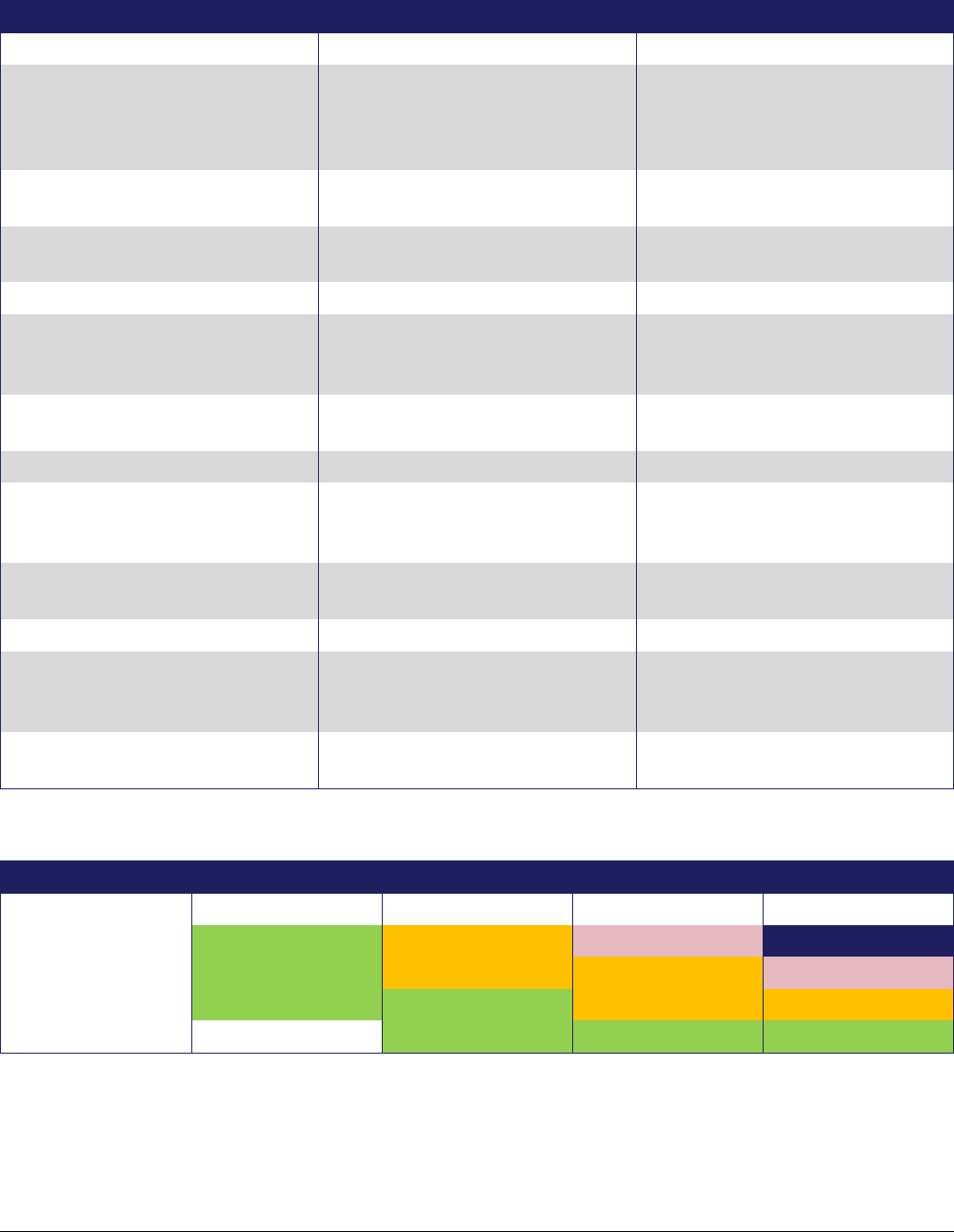
Detailed business case template
Department of
TRADE, BUSINESS AND INNOVATION
17 July 2019
| Version 1
Page 21 of 24
Impact Categories
Strategic Delivery
Finance, Legal and Regulatory
Reputation / Stakeholder
LEVEL 4. CATASTROPHIC
Community outrage
Large scale class action; Material
breach of legislation with very
significant financial or
reputational consequences
Extended NT-wide adverse
media coverage
Major adverse quality problem
Direct loss or cost overrun >20%
of project value
Intervention by Minister
Major milestone missed by > 1
year
LEVEL 3. MAJOR
Failure to achieve some
performance targets
Regulatory breach with material
consequences but which cannot
be readily rectified
On-going local, or NT- wide
adverse media coverage
Major milestone missed by 6 - 12
months
Direct loss or cost overrun of 10-
20% of project value
On-going local, or NT- wide
adverse media coverage
LEVEL 2. MODERATE
Some reduction in performance
Regulatory breach with minimal
consequences but which cannot
be readily rectified
Individual complaints
Major milestone or deadline
missed by 1 - 6 months
Direct loss or cost overrun 5-
10% of project value
Local temporary adverse media
LEVEL 1. MINOR
Negligible performance
reduction
Regulatory breach with minimal
consequences and readily
rectified
Negligible activity
Milestone missed by <1 month
Direct loss or cost overrun 0-5%
of project value
Negligible activity
Matrix for Rating Risks
Likelihood Consequence (Impact)
1. Minor 2. Moderate 3. Major 4. Catastrophic
4. Almost Certain
Low
Medium
High
Extreme
3. Likely
Low Medium Medium High
2. Possible Low Low Medium Medium
1. Unlikely Very Low Low Low Low

Detailed business case template
Department of
TRADE, BUSINESS AND INNOVATION
17 July 2019
| Version 1
Page 22 of 24
Risk Exposure Categories
Risk Category
Description
Score
Extreme Immediate action required Score of 16
High Senior Management attention needed Score between 10-15
Medium
Management Responsibility must be
specified
Score between 5-9
Low Manage by Routine procedures Score between 2-4
Risk has been considered Score of 1
Risk Management Strategies: Dominant Strategy
Risk Management Strategies are used to control a risk by reducing the likelihood or impact of a risk,
avoiding a risk situation arising or transferring the responsibility of the risk to another party. Under each
dominant strategy, specific actions should be identified and assigned to an Action Officer.
1. Likelihood Reduction – eliminating sources of risk or substantially reducing the likelihood of their
occurrence.
2. Risk Avoidance – a particular case of likelihood reduction, where undesired events are avoided by
undertaking a different course of action.
3. Impact Mitigation – minimising the consequences of the risk.
4. Risk Transfer – shifting responsibility of the risk to another party (also called risk sharing because
risks can rarely be transferred or shed entirely).

Detailed business case template
Department of
TRADE, BUSINESS AND INNOVATION
17 July 2019
| Version 1
Page 23 of 24
6.3.1. Risk Management Plan
Risks have been used to formulate that basis of contingency allocation. Risks that are identified will be reviewed and updated regularly with stakeholder
groups.
Risk
No.
Type of Risk Description of Risk Consequence
Likelihood
of Risk
Impact of
Risk
Exposure
Risk
Mitigation
Actions
Review Date Owner
1 Strategic
Delivery
Potential impact to
schedule (delays) and
or cost estimates
Possible Major Medium
2 Finance
Potential impact to
schedule (delays) and
or cost estimates
Almost
Certain
Major High
3
Reputation/
Stakeholder
Potential impact to
schedule (delays) and
or cost estimates
Possible
Moderate
Low

Detailed business case template
Department of
TRADE, BUSINESS AND INNOVATION
17 July 2019
| Version 1
Page 24 of 24
7. Endorsement & Gate Review
Seek agency endorsement in accordance with specific agency requirements.
Gate Review
Throughout the development of projects valued at $30 million and above, there are key decisions that
must be approved by the appropriate governance body. Agencies must submit strategic and detailed
business cases and related proposal documents for such projects to the Project Appraisal Board for review
and endorsement prior to seeking Cabinet approval for funding and progressing to the next stage of
project development.
Under the NTPDF, the Project Appraisal Board is comprised of senior officials from relevant agencies and
will ensure adequate details are provided in business cases.
The Project Appraisal Board has an assurance role which requires major project proposals to be critically
analysed in terms of the quality of the business case, particularly estimates of cost, time and resources; and
the level of confidence that the project will be successfully delivered on time, on budget and with planned
benefits realised.
8. Next Steps
Should this Detailed Business Case be approved, the next stage is to utilise agency-specific project
management tools to implement the project, including the performance measurement framework and
collection of data for the performance baseline.
All projects valued at $30 million or more are required, and other projects encouraged, to utilise the
NTPDF Benefits Realisation template to evaluate the benefits that were originally expected from a given
project. The document seeks to ensure/facilitate traceability of benefits throughout and post project
delivery.
Post Implementation Review
Once all deliverables have been finalised and the asset has been commissioned and in operation, a post
implementation review of the overall project should be undertaken.
The review will focus on the success factors and opportunities for improvement, including but not limited
to:
• Review of final scope compared to original scope
• Analyse the actual outcomes of the project against the expected outcomes set out in Section 2.4.1.
• Assurance that the contract management plan captures the relevant contractual information
• Financial control and accuracy for project duration
• Influencing factors that changed, altered, impaired or improved the delivery of the project
• What opportunities remain going forward, and
• Complete a NTPDF ‘Lessons Learned’ Register.
